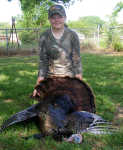- Missouri campgrounds resurgence (5/30/20)
- August a fantastic month for catfishing (8/11/18)
- Kayaking, canoeing good way to spend hot summer days (7/27/18)
- Hot weather means hot catfishing (7/7/18)
- Boat buyers have abundant options (6/16/18)
- Warm weather invites camping (6/9/18)
- Topwater fishing is a blast (6/2/18)
As turkey season winds down hunters should plan accordingly
Saturday, May 9, 2015

Submitted photo/
Shanae Potts, 13 of Jerico Springs, with her second turkey. Her first bird was taken during last years youth hunt.
Nevada Daily Mail
After the first two weeks of the three week spring turkey season, Missouri turkey hunters have taken 36,464 bearded birds. Prior to the opening, Jason Isabeel, Missouri Department of Conservation turkey biologist, said he looks for another good season.
With only the weekend left in the season, things change so hunters have to change their set-ups and calling strategies.
Many hens will be nesting, but young hens will be broadcasting their availability. Those are the birds hunters need to observe as many toms are listening. This late in the season there is more foliage that make it more challenging for both hunters and turkeys as the season nears the end. The increase in foliage can be an asset. Hunters need to cover more ground in the late season, so the cover makes mobility and concealment easier. Late season hunters should check paths and clearings where they can observe more and won't need a ground blind they may setup just about anywhere.
Another game-changer in the late-season is that there is less competition for real hens ---- so should you find a tom that isn't "henned- up," he might be a sucker for proper calling. In my experience, toms seem to make more mistakes during the late-season, so if you put out a hen and take a decoy like I do, a tom won't be able to just brush off so let him make a mistake, not you.
Most successful turkey hunters avoid mistakes, by watching, listening and using their strategies accordingly. Everyone still makes mistakes, but with experience, hunters make adjustments. Spending enough time in the woods, the turkeys will show you what they want.
As outdoor sports go, turkey hunting is pretty safe. The National Safety Council has shown that Missouri has averaged about one accident for every 17,000 spring turkey hunters. For comparison, one out of every 91 persons who played baseball suffered injuries requiring emergency room treatment. Turkey hunting even looks good compared to such sedate activities like golf and billiards, which had injury rates of one per 613 and 6,666 participants respectively.
However, these stats, encouraging as they are, gloss over one not-so-encouraging fact. Turkey hunting is Missouri's most dangerous type of hunting.
Turkey hunters are more likely to hurt each other because they make themselves virtually invisible with camouflage and imitate the sounds of real turkeys, but turkey hunting is getting safer. The trend of safer hunting is due in part to the hunter safety education program that became mandatory.
Turkey hunters know that one of the most appealing things about turkey hunting is the excitement it generates. They want to see a turkey and when they see something moving in the woods they may let their excitement cloud their judgment.
Turkeys don't look like humans. There is no excuse for failing to identify the target before shooting. After the first two weeks of the three-week season, there were four hunting related accidents, one of them fatal.
Responsibility for mistaken identity belongs to the shooter. It is just as important to take measures to avoid becoming a victim. Some defensive turkey hunting safety tips include:
* Don't hunt in areas that you know others are using. They could mistake you for game or unknowingly catch you in their line of fire.
* If you should see another hunter, shout to identify yourself. Never wave, the movement of your camouflage form could draw fire from a careless shooter.
* Don't assume that you are the only hunter in the area.
* Don't wear or carry anything red, black, blue or white because these are colors associated with tom turkeys.
* Be careful where you place your decoys because they could draw fire.
With just a few days left in the spring season, don't be a victim. Play it safe.

